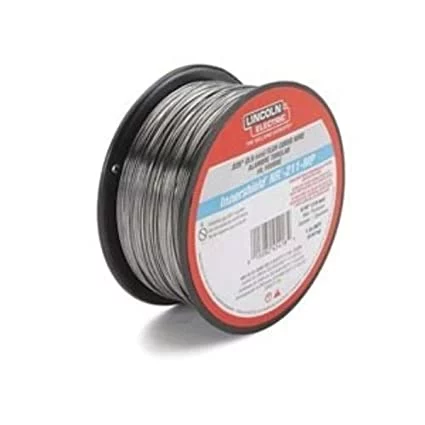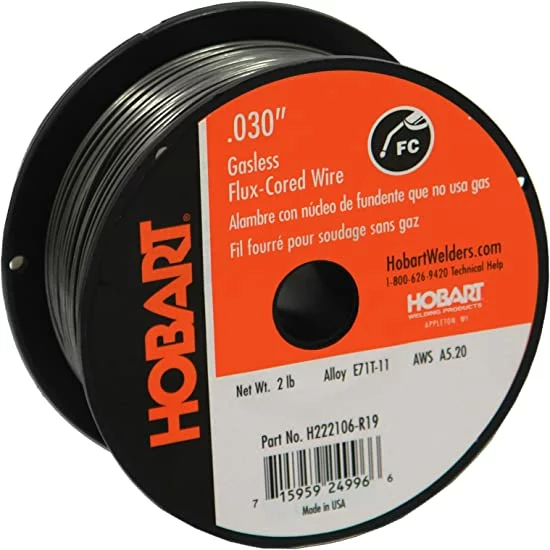If you are ready to accelerate your welding skills to the next level, it’s time to upgrade your best .030 flux core wire.
It can be hard to know what size to choose and which product is best, but in this article, we’ll discuss everything you need to know to make the right decision.
Table of Contents
- What Is Flux Core Welding Wire?
- What’s The Difference Between .030 And .035 Welding Wire?
- How To Choosing What Flux Core Wire To Use
- Best .030 Flux Core Wire
- Conclusion
What Is Flux Core Welding Wire?
There are multiple types of welding wire, one of which is the flux core. It is the type of wire that you can use with MIG systems.
One of the main benefits of flux core welding wire is that it lets you weld without needing a separate shielding gas cylinder.
It eliminates the need for external gas storage through the flux composition, an outside layer on the wire.
When you apply a substantial amount of heat using a MIG welding tool, the flux melts to produce shielding gas directly.
It then leads to a normal welding process.
Flux core wire is suitable in various situations, but it is most common for outdoor use where the weather could prevent the storage of shielding gas.
It is also exceptionally useful if you’re in a small or inaccessible location where carrying large amounts of equipment, such as gas cylinders, would be difficult.
What’s The Difference Between .030 And .035 Welding Wire?
What’s The Difference Between .030 And .035 Welding Wire?
.030 and .035 are the two most common types of flux core welding wire you’ll see on the market.
The numbers of each type represent the thickness of their respective diameters in inches.
Sometimes, experienced professionals shorten the name to just “thirty” or “thirty-five” to save time.
How To Choosing What Flux Core Wire To Use
How many Amps are available?
One factor to consider when choosing which flux core wire to use is your welder’s power output. 0.35 flux core wire will require much more power output to function properly and produce a high-quality result, so if you don’t have this option, you should consider 0.030 as your top priority.
How Thick Is The Metal You’re Welding?
The thickness of the metal you are welding is also an important consideration.
So, as a result, if you have a thin, small piece of metal that you’re trying to weld, then sticking with 0.030 may be okay.
If you move into thicker metals of a quarter inch or more, you’ll probably need 0.035 inches of wire thickness to get by.
Are The Joints Straight And Clean, Or Are They Wide And Variable
The level of consistency in the metal you’re welding is a fantastic indicator of whether you should use 0.030 or 0.035 flux core wire.
The reason for this is that straight and clean joints require a lot more filler metal when compared to wide and variable joints.
It means you can weld clean, straight joints quite easily with a 0.030 wire, but more complex, wide, and variable joints will likely require you to use a 0.035-inch wire.
Flux Core Wire For Single Pass Or Multiple Passes
Flux core wires have different capabilities regarding the number of passes required.
You need to know how many passes your welding job will require, and then you can decide whether a single-pass or multi-pass wire is right for you. If you choose the wrong one, your joints will be less durable and faulty.
Best .030 Flux Core Wire
1. YesWelder Flux Core Gasless Mig Wire

Features & Benefits
- Firstly, this wire is of a very high standard, which makes it easy to weld.
- Secondly, a flux core wire does not require a shielding gas.
- Lastly, you can use it for single-pass and multi-pass welding so that it will work for all your needs.
Downsides
- Shipping is quite poor, and products can often arrive damaged or faulty.
Customer Reviews
“Great welding wire; I love that it comes in 2 pounds. I really recommend it. Look no more.”
2. Lincoln Electric .030 NR-211 Spool

Features & Benefits
- Firstly, the wire is strong, mild steel that is highly durable and will last long.
- Additionally, it has an excellent weld and bead appearance.
- Thirdly, its freezing characteristics mean it can accommodate a poor fit-up.
Downsides
- There are many splatters, which can be very annoying and hazardous.
Customer Reviews
“It is as good as any I’ve used. Fair price and speedy delivery.”
3. Forney 42300 Flux Core Mig Wire

Features & Benefits
- Firstly, this is an all-position flux core MIG wire for mild steel.
- Also, it works extremely well on all sorts of material qualities, including rusty, dirty, and painted steel.
- Finally, it suits outdoor wind, rain, and sun exposure.
Downsides
- It is not the highest quality wire on the market and can be somewhat greasy and dirty.
Customer Reviews
“The price is very reasonable, and it is easier to weld with than the wire I have previously used.”
4. Hobart 2-Pound Carbon Steel Welding Wire

Features & Benefits
- Firstly, it works exceptionally well on both thin-gauge mild and galvanized steel.
- Additionally, you can use it for both single and multi-pass welding jobs.
- Lastly, this wire will work well for construction, machinery, prefab, etc.
Downsides
- The advertised product can appear as a twin pack but is just one pack.
Customer Reviews
“Great welds, virtually no spatter.”
Conclusion
This article covered everything you need to know when choosing a .030 flux core wire.
This type of wire is 0.030 inches wide and is best for thinner metals and smoother, more consistent joints.
